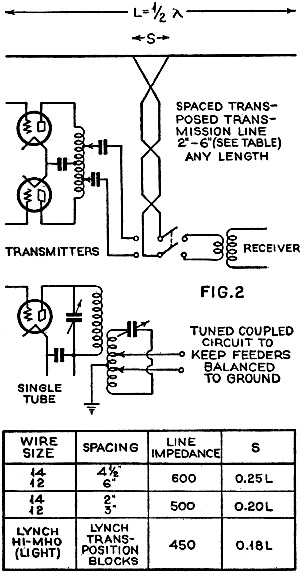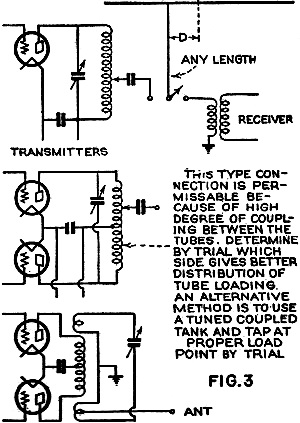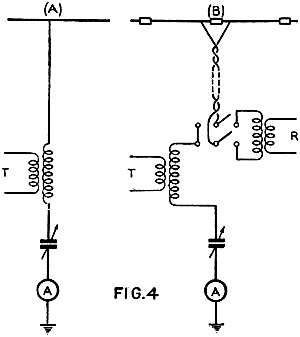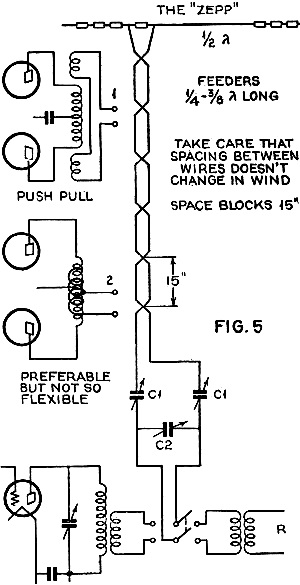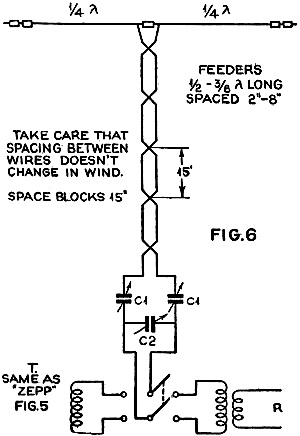July 1934 Radio News & Short-Wave |
 [Table
of Contents] [Table
of Contents]
Wax nostalgic about and learn from the history of early
electronics. See articles from
Radio & Television News, published 1919-1959. All copyrights hereby
acknowledged.
|
One of the nice things about
antenna design articles is that regardless of when they were written, all that is
needed to make them entirely contemporary is to substitute a transistor schematic
symbol for a vacuum tube and substitute the units "kHz" and "MHz" for "kc" and "mc,"
respectively. If the article delves into detailed circuit design, a substitution
of "μF" for "mf" might also be required and depending on the frequency range,
"pF" for "mmf" or "μμF." Some readers might feel the urge to replace SAE units with
metric units, but even a hundred years ago there were people who needed to do that.
"Aerial" and "antenna" are still interchangeable in modern radio parlance. With
that in mind, please enjoy this 1934 article on basic antenna design.Practical Amateur Aerial Design
The one big job for an antenna is to "soak up juice" from the transmitter and radiate
as much energy as possible into space. An antenna must be resonant and should be
properly coupled to the power source
A. H. Lynch (W2DKS)
E. Glaser (W2BRB)
The type of antenna system to be used for amateur short-wave work is of secondary
importance and depends largely upon the individual location and the frequency bands
to be covered in regular operation. Some types are easily adapted for multi-band
work while others are suited to only a single frequency band. In general, the latter
types are somewhat more efficient but not obviously so. The object of this article
is to bring together some practical information to help in choosing the most suitable
antenna system for particular cases.
Better efficiency usually results in using a Hertz antenna (1/2-wave wire in
free space) than when using the 1/4-wave Marconi type which must have a good ground
system or a large counterpoise. (In this latter type every inch of wire in the system
radiates energy, so that a rather small percentage is radiated by the uppermost
parts of the antenna which do the business.) The horizontal Hertz, on the other
hand, is entirely up-in-the-air so it becomes obvious why the efficiency is better.
And, of course, this applies equally well to signals coming in. Antenna systems
for single-waveband operation will be first considered.
This simple half-wave antenna diagrammed in Figure 1 is a split doublet, each
side being one quarter wavelength long. The length of each half equals 0.78 times
the wavelength or 468 / (2 x frequency [mc.]).
It is ideal for portable work at any frequency and does a first class job for
both transmitting and receiving. The transmission line used to couple this doublet
to the transmitter or receiver need not be tuned and can be of any length provided
its impedance is correct. Forms of rubber-covered, twisted lamp cord provide a suitable
impedance match.
"Giant Killer" feeder wire is intended especially for this purpose. Its impedance
is slightly higher than that at the center of the antenna (about 75 ohms) so that
it should be fanned somewhat when connecting to either side of the center insulator
to be theoretically correct. This type of antenna is suited only to the waveband
(fundamental) for which it is cut or any odd harmonic thereof. On even harmonics
a voltage (and impedance) maximum appears at the center and cannot be matched to
(is virtually short-circuited by) a 75-ohm line. When used for receiving, the line
will have no pickup and, therefore, a maximum signal-to-noise ratio will result.
The line is magnetically coupled to the receiver by means of a small primary coil;
to the transmitter across a few turns of the last plate-tank coil or coupled same
as receiver. Bear in mind the necessity for sufficient insulation in the twisted
line when used for transmitting.
Another method of feeding a half-wave Hertz is to use a spaced transmission line
fanned at the antenna so that the impedance of the line equals that of a part of
the antenna across which the line is connected. See Figure 2. The length of this
antenna and the distance between the wires are quite critical. The length equals
463 / (frequency [mc.])
The distance (S) equals one-quarter the antenna length for a 600-ohm line, and
decreases as the line impedance goes down. See table in Figure 2. A transposed line
may be used and is particularly desirable for reception. The line should be perpendicular
to the antenna for at least 1/4 wavelength and should be terminated in such a manner
at the transmitter so that it is balanced to ground. Transposition blocks make an
easy and efficient job of the feeder. In putting up this type of antenna, the wire
should be several percent too long and should be cut about one percent at a time,
observing the performance after each cut. Fixed coupling to the transmitter (or
an oscillator) should be used so that the loading effect of the antenna might be
seen on the plate (or grid) milliammeter. When the doublet length is correct, it
will have a maximum load effect.
A third type of antenna for single-band operation is the single-wire feeder affair
shown in Figure 3. The length of the antenna is roughly the same as the previous
type but had better be determined by experiment, as previously explained. The feeder
should be connected one-seventh the length off the center and must run at right
angles for proper operation. There must be no sharp bends in this feeder or there
will be reflection losses and line radiation. This type is less suitable for reception
than either of the foregoing systems because the line is not so free from pick-up.
In the foregoing antennas, properly designed and constructed, there should be
no radiation or pick-up on the feeder and any length at all may be used. If no radiation
or pick-up takes place in the feeder, the half-wave antenna is doing all the work,
which is exactly what we want. And in this case there is a marked directionality,
best transmission or reception being at right angles to the line of the antenna.
In adjusting these antennas to the transmitter, the plate meter must be used as
the antenna current in the feeders is very low and is not necessarily a true indicator
of power taken by the antenna proper. Start with a minimum of coupling and gradually
bring it up, always retuning the plate-tank condenser, until the tube is properly
loaded. It is possible to use any of these types as a Marconi antenna for lower
frequencies, tying the two feeders together. In a pinch this means may also be used
on odd harmonics of the Marconi quarter-wave fundamental but, at best, is a makeshift
job.
The single-wire-feed antenna of Figure 3 may be used for all amateur frequencies
but does not perform as well on harmonics as on the fundamental frequency. This
is because there is a mismatch between antenna and feeder on harmonics. It is possible
to compromise and improve harmonic operation but usually at the expense of fundamental
efficiency. The feeder is usually moved further from the center of the antenna.
The feeder radiates, standing waves appear and there are losses all around. Nevertheless,
many hams like this method because of its utter simplicity and obtain good results
with it. It should be cut for the lowest frequency band to be used or, if this demands
too great a stretch. Marconi operation may be used on the highest wavelength, the
antenna being cut for one band lower.
A second all-band antenna may be procured by simply cutting any single wire (plus
lead) into a half-wavelength for the lowest frequency band to be used. Operation
with a ground may also be used as above. This is really a voltage-feed type with
a feeder of zero length. The end of the antenna is plenty "hot" and should therefore
be hung close to the plate on the tank coil. A separate tank of low capacity (to
reduce losses) may be coupled to the plate tank and the antenna hung on to that.
A ground is sometimes used at the other end of this coupled circuit. However, some
losses are bound to appear as the antenna comes into the shack and into the vicinity
of other apparatus. Not only that but there is a strong field around the antenna
which may be a nuisance - affecting neutralizing, paralyzing the receiver, etc.
Of course, the entire length of wire radiates so that a lot of energy may be wasted
before it gets to the high part of the system. The length should be adjusted experimentally
as with previous systems because the antenna proper, coming into the shack, is subject
to all kinds of influences which might affect the fundamental, or natural frequency.
This antenna is equally good on all harmonics because the ends of an antenna are
always maximum voltage points (Figure 4).
A third type, permitting many-band operation is the old, reliable "Zepp," (Zeppelin)
which is about the easiest antenna to resonate because a certain amount of tuning
may be done right at the transmitter or receiver. See Figure 5. A half-wave antenna
is used with quarter-wave feeders. This might be considered a full-wave affair with
half a wavelength "folded," so that a point of maximum current comes right at the
feeder end. This is a true current-fed antenna, the losses appearing in the previous
voltage-fed system being entirely absent here. Although the feeders must be a quarter-wavelength
long, electrically, much leeway is possible by loading or cutting with parallel
or series-tuning condensers. When multi-band operation is desired, a compromise
in length must be made to accommodate tuning to the various harmonics, the most
reasonable length being a little under three-eights wavelength. This is not at all
critical, compared to the chopping of the flat tops for this family of antennas,
but should be quite close. This limitation of feeder length which appears here for
the first time in this series of antenna systems, might be worse were it not for
the fact that the feeders may be bent or folded to add length. Again, the half-wave
flat-top might well be cut too long and chopped although this is less important
with the Zepp than with most of the other types. Most hams do not get a proper balance
of feeder currents so the feeders do some radiating. Even so, the results obtained
usually justify this old favorite. It is because some leeway is possible that they
don't take the necessary pains to do n perfect job. This is really an unbalanced
system, but it does a lot toward improving the signal-to-noise ratio, especially
when transposed feeders are used. However, in our opinion, the following antenna
is really the ace of all wave receiving aerials.
Figure 6 shows another very flexible system. this time a balanced "split" arrangement
that resembles the first shown doublet, but which is really a one-and-a-half-wave
antenna with two half-wave parts, folded as feeders. Since a current maximum exists
in the center of the antenna we need half-wave feeders this time, to get back to
another current maximum for current feed. Again, compromising in feeder length for
the sake of the harmonic family, the feeders should be the same length as in the
Zepp. This will allow tuning to all bands in a similar manner. In both this type
and the Zepp, the full voltage of the antenna appears on the feeders, so that the
spacers must be first-class insulators and of low dielectric constant. When a transposed
line is used this antenna is excellent for reception. although tuning must be used!
This is the most versatile aerial of the whole bunch for multi-band use and will
cover a large part of the short-wave spectrum.
To correct a common fallacy, solid wire has not the lowest high-frequency resistance
but, rather, a sort of cable made of insulated wires, tightly twisted together,
presents a much lower resistance than the equivalent solid wire.
Posted February 2, 2022
(updated from original post on 8/13/2013)
|









